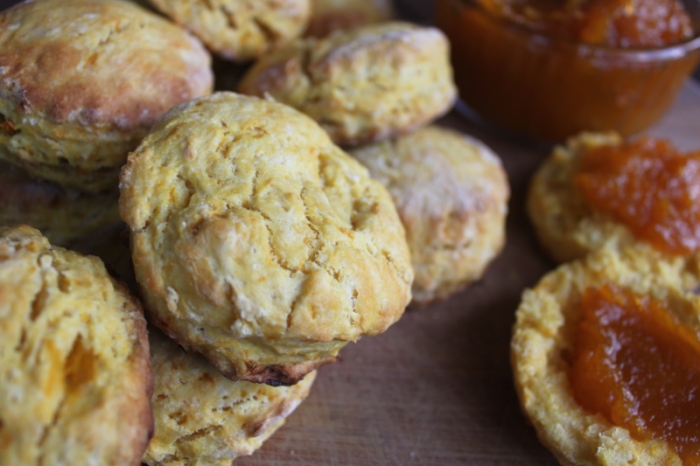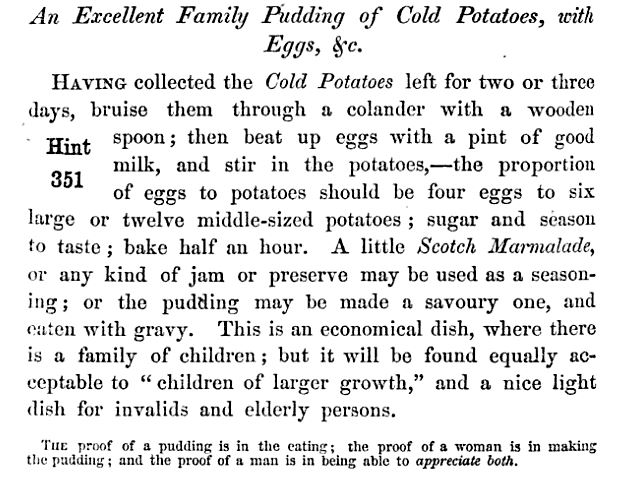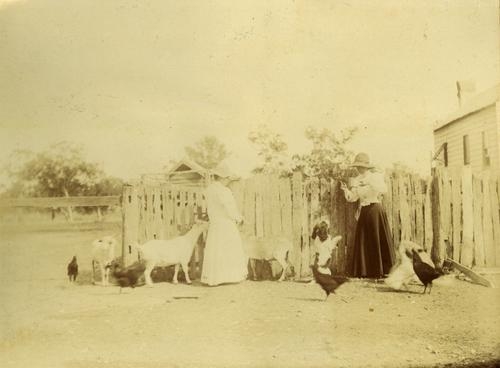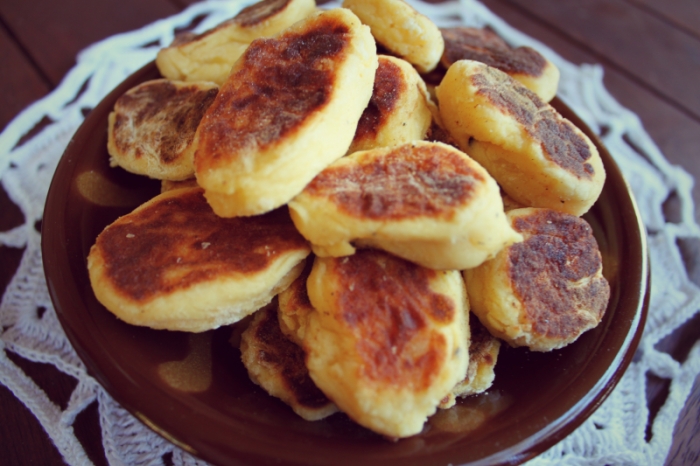Its winter in Australia, and that means one thing. Pumpkin! I have to admit that pumpkin is one of my favourite ingredients because it is just so versatile. It can be used in sweet or savoury dishes, from curry to cake and let’s face it, at less than $1 per kilo during the season its great value too. This week for the Seasonal Fruit and Vegetable challenge (you can read more about the Historical Food Fortnightly challenges here) I’m offering a selection of pumpkin recipes for your delectation.

Pumpkins at Bathurst. Image courtesy of the State Library of New South Wales.
But first, a quick history of the pumpkin. Native to the Americas they had been a staple food for centuries before the arrival of the colonists (who called them ‘pompions’). Thanks to the ease of cultivation and high yields they quickly became an essential part of the colonists’ diet in a variety of guises: stewed, baked, turned into soups, added to stews or baked into pies. Nonetheless, in spite of its role in early American myth, pumpkin remained a food primarily for the poor, celebrated in times of dearth[1].
Pumpkins were also stigmatised in Europe where they were grown primarily as animal fodder or food for the impoverished. The pumpkin seeds transported on the First Fleet in 1788 may have simply been intended as animal feed, or perhaps cheap, abundant food. Nonetheless, the plants thrived in the Australian climate and Marine officer Watkin Tench described them growing “with unbounded luxuriancy”[2] even in Sydney where the soil had generally proved a disappointment. Once again, a variety of dishes were made, even baked whole in the fire as depicted in Richard Wingfield Stuart’s paintings of bush camps which you can see here and here.
It wasn’t really until the 19th century though that cooks popularised some of the more iconic pumpkin recipes including pumpkin scones, pumpkin jam and boiled pumpkin fruit cake (the mashed pumpkin adds tenderness and moisture)[3].
So next time you see pumpkin on sale, why not try one of these three Australian historical recipes? I haven’t provided redactions because once again they seem very straight forward.
Recipes

To Cook Pumpkin – Cut a pumpkin into several pieces, pare it, and take out the seed: cut it equally into small squares one inch in size, blanch them in boiling water, drain, put into a stew-pan with enough butter, parsley, sliced onions, pepper and salt to taste. Toss it over the fire till tender, then serve with rich melted butter, or a thick brown gravy.[4]
This recipe made a nice side dish, very simple and tasty!
A recipe for pumpkin scones:- One cup of boiled pumpkin (any left over from the day previous can be used), two cups of flour, two teaspoonfuls of baking powder, a little salt and sugar, and a piece of butter the size of a walnut. Rub the butter and pumpkin into the flour, and add the other ingredients: then mix with milk, and bake in a quick oven.[5]

These made lovely, airy scones with a delicate orange blush. Perfect with butter, or pumpkin jam (see below)! In terms of proportions I used 1 cup of mashed pumpkin, 2 cups of flour, 30g butter, about 1/2 cup of milk, 2 tsp baking powder, 2 tbsp. sugar and 1/2 tsp. salt. I rubbed the butter into the flour, then mixed in the pumpkin followed by the remaining dry ingredients. I then added enough milk to make a soft, pliable dough. I rolled it out quite thick, cut into circles, brushed with milk and baked at 180˚C for about 15 mins.
The final recipe for this fortnight is a rather unusual one. It is a recipe for pumpkin jam, but instead of being slowly cooked on the stove the ingredients are put in a casserole dish and baked in the oven. This is a technique that I have only seen a couple of times (as a non-historical side note, this technique is used in this recipe for the most amazing plum butter you have ever tasted) and never for pumpkin. The inclusion of vinegar is also a bit odd, so I just had to try it.

A Pumpkin “Jam” – Just Pumpkin, Vinegar and Sugar
A country woman wrote me the other day that she was almost ashamed to contribute her pet recipe to our columns, but it is so good that if my friends will but make some, they will bless the contributor, who says :- “We call it pumpkin butter, and the sweet or pie pumpkins are the best for it, although almost any pumpkin will do. Stew it, and when it is tender, add to each gallon of pulp a cupful of vinegar and six cupfuls of sugar. Instead of baking your face stirring this over a fire, put it in a stone crock, or if that is too small a granite iron dishpan, and let it cook in the oven, while you are washing or ironing, or otherwise using the fire. It will save an extra fire and the flavour of the pumpkin butter will be better. It should cook till thick enough to stand in a saucer without being juicy, and then it is good enough to make any time. The baking gives it a distinctive flavour, and if you will recall the difference between stewed and baked apples you will be more ready to try this labour and fire-saving way of making pumpkin butter.[6]
The country contributor was right, this is definitely a very easy way of making pumpkin butter, although it is perhaps a bit plain for modern tastes. I would have like to have added something to spice it up a little: cinnamon, nutmeg, cloves and maybe even a little lime juice. Nonetheless, I was surprised at how successful it was, I have to admit that I wasn’t sure it would work at all. Again, for the proportions I used about a kilo of pumpkin which gave me 2 cups of pulp. I mixed that with 1/6 cup of plain, white vinegar and 1 cup of sugar and baked at 180˚C for about an hour. You need to keep an eye on it to make sure that the bottom doesn’t burn, and you know that it is ready when a little spoonful on a plate doesn’t seep water. Serve hot or cold with scones or fruit bread.
The Recipe: Stewed Pumpkin (available here); Pumpkin Scones (available here); Pumpkin Jam (available here)
The Date: 1907; 1902; 1912
How did you make it? See above.
Time to complete?: 30 mins; 30 mins; 1 1/2 hrs
How successful was it?: All three were very tasty. The stewed pumpkin looked somewhat unappetizing but tasted very good while the pumpkin jam could have used some spices. The scones, however, were pretty much perfect.
How accurate?: I think they were pretty accurate, it’s certainly a lot easier using more modern recipes!

[1] Cindy Ott, Pumpkin: The Curious History of an American Icon (University of Washington Press, 2012), 6.
[2] Watkin Tench, A Complete Account of the Settlement at Port Jackson in New South Wales (London: G. Nicol and J. Sewell, 1793), chap. XVII.
[3] Barbara Santich, Bold Palates: Australia’s Gastronomic Heritage (South Australia: Wakefield Press, 2012), 10–11.
[4] “SELECTED RECIPES.,” The Corowa Chronicle, July 6, 1907.
[5] “MORE USES FOR PUMPKIN.,” The Sydney Morning Herald, June 15, 1920.
[6] “A PUMPKIN ‘JAM.’ Just Pumpkin, Vinegar and Sugar.,” The Farmer and Settler, July 9, 1912.
Bibliography
“A PUMPKIN ‘JAM.’ Just Pumpkin, Vinegar and Sugar.” The Farmer and Settler. July 9, 1912.
“MORE USES FOR PUMPKIN.” The Sydney Morning Herald. June 15, 1920.
Ott, Cindy. Pumpkin: The Curious History of an American Icon. University of Washington Press, 2012.
Santich, Barbara. Bold Palates: Australia’s Gastronomic Heritage. South Australia: Wakefield Press, 2012.
“SELECTED RECIPES.” The Corowa Chronicle. July 6, 1907.
Tench, Watkin. A Complete Account of the Settlement at Port Jackson in New South Wales. London: G. Nicol and J. Sewell, 1793.








![Rock Wallaby in Rocks. By Bilby (Own work) [CC-BY-3.0 (http://creativecommons.org/licenses/by/3.0)], via Wikimedia Commons](https://turnspitandtable.files.wordpress.com/2014/09/rock_wallaby_in_rocks.jpg?w=211&resize=211%2C300)








